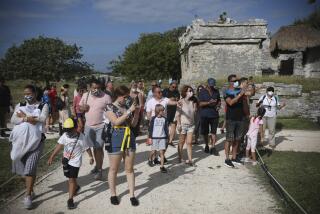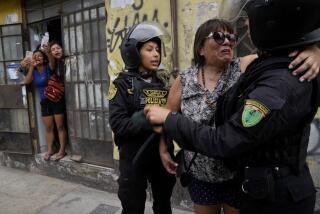Journey to Machu Picchu Is Uphill All the Way
- Share via
MACHU PICCHU, Peru — As the three-car tourist train rushes down the lush valley along the Urubamba River, guides sidle passenger-to-passenger with whispered messages.
“Machu Picchu is near,” they murmur. “Go to the door now. When the train stops, run to the bus. Run fast.”
A few run fast enough. Those who do not are likely to find themselves more disillusioned than enchanted with their visit to the mountainside Inca citadel that is one of South America’s premier tourist attractions.
Too often, thousands of miles and thousands of dollars are undercut by a $1.33 bus ride.
Machu Picchu’s lure begins broadly in dreamers’ living rooms across continents. It narrows ultimately to a single dirt track and half a dozen weary buses that make hostages of visitors from London, Lima and Los Angeles with undiscerning indifference.
The Incas would have done it better.
So poor is the system, so clogged is the bottleneck, that visitors to Machu Picchu today may find themselves spending more time in line for ramshackle buses than touring the magnificent ruins.
There is no road through the valley to Machu Picchu. The world comes by train to the valley bottom and climbs by bus to the city in the sky justly proclaimed by the United Nations as a patrimony of mankind.
The bus line, run as a government monopoly (Empresa Nacional de Turismo), charges $1.33 round trip for the steep and spectacular five-mile, 20-minute trip from the train station to the ruins.
In principle, the company operates 12 elderly cream-and-green Dodge vans with 22 seats each. One recent rainy morning, six vans were running, to use the term euphemistically. The other six lay dead and rusting in an eyesore clump at the entrance to the ruins.
The buses serve a single purpose, operating exclusively between the train station and the ruins. They are the weak link in an otherwise winsome chain.
Two year-old, 180-seat tourist trains run to the ruins from the old Inca imperial capital of Cuzco each day. One leaves at 7 a.m., arrives at around 10 a.m. and is scheduled to return at 3:05 p.m.--but it is often bus-delayed. The second is one hour behind.
To overwhelm a fleet of buses whose brakes, steering, transmissions and tires are best neither seen nor imagined, is added one more cruel burden.
Each morning at 5:30 a regular train leaves Cuzco for a leisurely run down the valley, stopping in the interests of neighborhood commerce and transportation at small settlements seen only as blurs from the foreigners’ express.
Only a handful of backpacking tourists rides the cheaper local, but for Peruvian students with a yen of their own to see what their ancestors built, it is the only way to Machu Picchu.
The student-jammed local arrives at the Machu Picchu station about 10 minutes before the first tourist train. The students, as excited as the tourists, and no less deserving, bound for the buses.
When the first tourists arrived that rainy day, nearly 100 students stood boisterously in line waiting to go up the hill.
The tourists fell in behind them, fellow prisoners in a cramped and smelly concrete shed. The only ones who seemed to enjoy the long and gnawing wait that followed were the insatiable “Hey, mister” hawkers of guidebooks, T-shirts and silver jewelry of doubtful provenance.
The last tourist from the first express finally reached the ruins at 11:50 that morning, an hour and 50 minutes after leaving the train.
There followed a breathtaking but breathless tour of Inca splendor that lasted about 90 minutes.
By 1:30 the dreary bus lines had formed again, this time in the rain; more than 200 students and tourists awaiting a rattletrap journey back to earth.
Officials of the bus monopoly and of agencies in Cuzco that sell the package tours say the problem is chronic. Predictably, and unreasonably, they blame the students.
For months the bigger agencies have been pressing for permission to run their own buses for their own passengers between the railroad and the ruins. The government refuses. What good is a monopoly if there is competition?
There is one way to beat the system for visitors unwilling to compress a once-in-a-lifetime spectacle into 90 minutes of awe between buses.
At the ruins is a 32-room government hotel. Those able to make reservations two or three months in advance to stay the night not only better savor the majesty of Machu Picchu but also wisely spread their bus agony over two days.
More to Read
Sign up for The Wild
We’ll help you find the best places to hike, bike and run, as well as the perfect silent spots for meditation and yoga.
You may occasionally receive promotional content from the Los Angeles Times.






